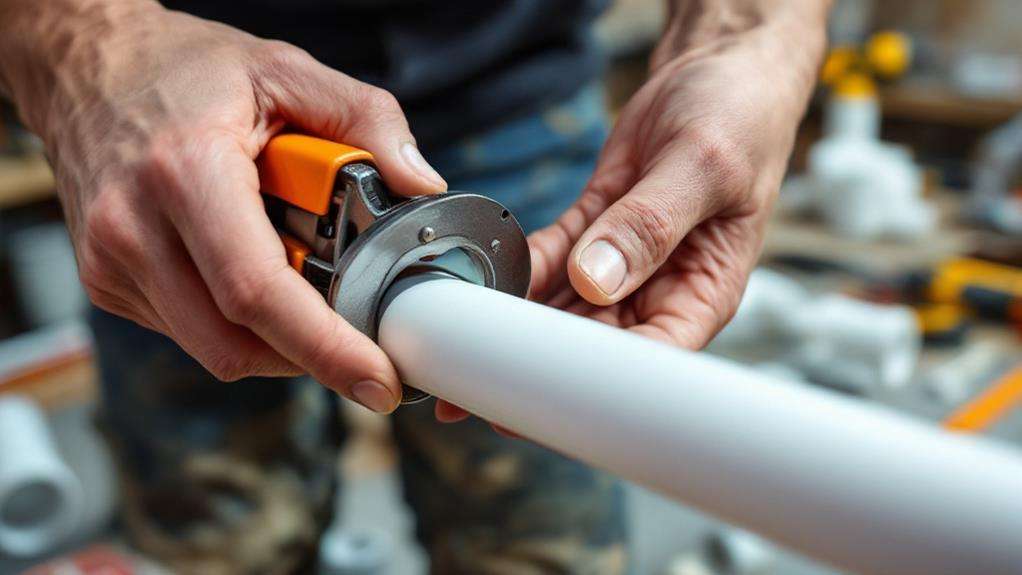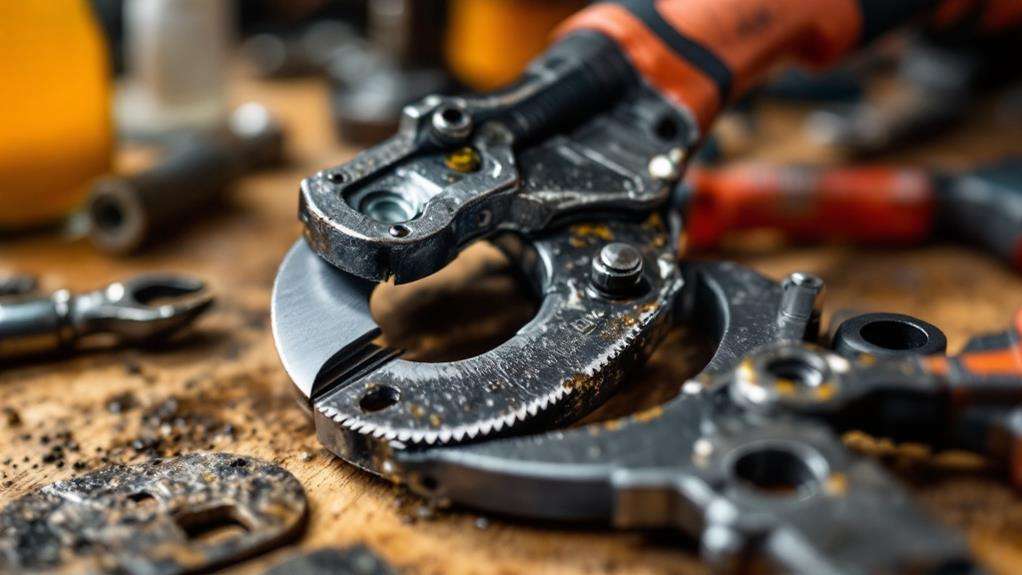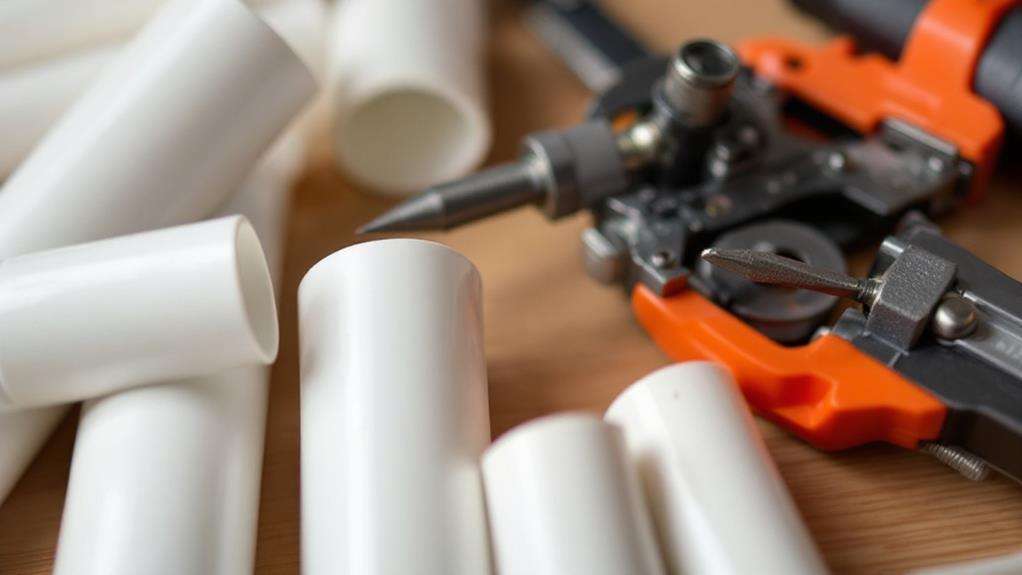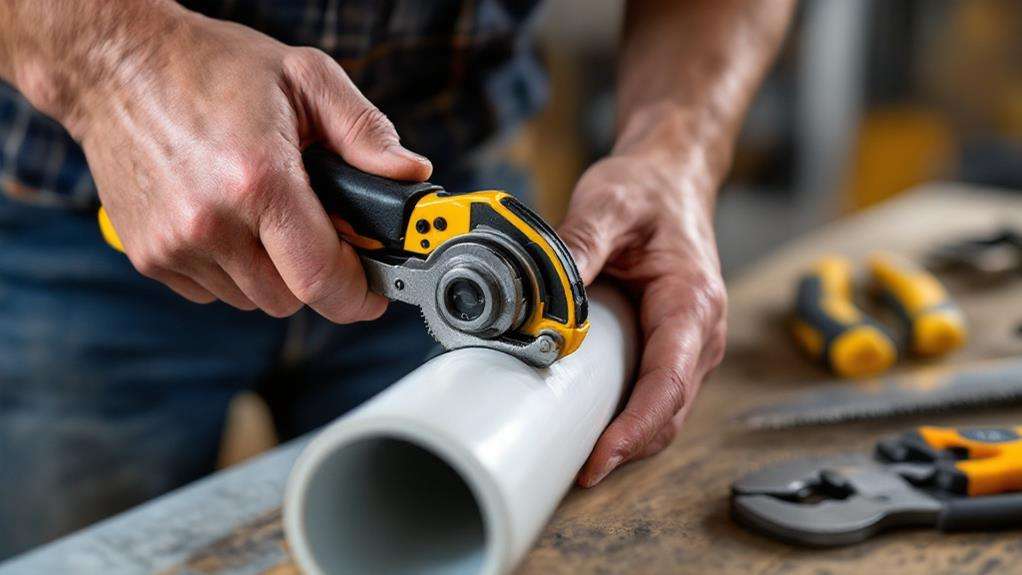A Guide to PVC Cutting Tools for Plumbing Projects
When tackling plumbing projects, you'll need the right PVC cutting tools for clean, precise cuts. Ratcheting pipe cutters are ideal for larger pipes, while rotating cutters work well for thinner tubing. For versatility, consider adjustable pipe cutters that can handle various materials. Don't forget alternatives like hacksaws or power miter saws for specific needs. Always prioritize safety by wearing protective gear and securing pipes properly. Maintain your tools regularly to guarantee maximum performance, and avoid common mistakes like inaccurate measurements or failing to deburr edges. By choosing the right tool and technique, you'll certify successful PVC pipe installations and repairs. The world of PVC cutting tools offers even more specialized options for your plumbing arsenal.
Types of PVC Cutting Tools
PVC plumbing projects require the right tools for clean, efficient cuts. When selecting cutting tools for your PVC pipe work, you'll find several options tailored to different needs and pipe sizes.
Ratcheting pipe cutters are often considered the best overall choice for PVC pipes. They can handle sizes from 1/2 to 1 1/2 inches in circumference with ease, making them versatile for various plumbing projects. Rotating pipe cutters work similarly but are better suited for plastic tubing, PEX, CPVC, and thin PVC due to their reliance on sheer force.
For more heavy-duty applications, adjustable pipe cutters can cut through metal, copper, aluminum, and other hard materials in addition to PVC. If you're looking for alternatives, hacksaws, scissor-type cutters, and power miter saws are effective options, each offering unique advantages.
When using any of these cutting tools, it's important to secure the pipe properly to guarantee a clean cut. Remember, using the right tool not only makes your job easier but also ensures a safe working environment and a functional end result. Choose the appropriate PVC cutting tool based on your specific plumbing project requirements and pipe sizes.
Selecting the Right Tool
When selecting the right PVC cutting tool, consider three key factors: the pipe size, the material thickness, and the frequency of use. These elements will help you determine which type of pipe cutter best suits your plumbing project needs.
For larger, thicker PVC pipes, you'll want to opt for ratcheting pipe cutters. They're designed to handle more substantial materials and provide an easy-to-use mechanism for cutting through significant PVC pipes. If you're working with thinner plastic tubing, rotating pipe cutters might be a more suitable and cost-effective choice. They're specifically designed for smaller diameter pipes and offer precise cuts on thinner materials.
If you need versatility in your cutting tool, adjustable pipe cutters are an excellent option. They can handle various pipe sizes and materials, including metal and copper, making them ideal for diverse plumbing projects. However, they may be overkill for simple PVC-only jobs.
Remember to match the tool to your specific project requirements. Consider the pipe size you'll be working with most frequently and the types of materials you'll encounter. By choosing the right PVC cutting tool, you'll ensure cleaner cuts, improved efficiency, and better overall results in your plumbing projects.
Proper Cutting Techniques

Now that you've chosen the right tool for your PVC cutting job, it's time to focus on proper cutting techniques. Your approach will depend on the tool you're using, but the goal remains the same: achieving a clean, straight cut.
If you're using a hacksaw, secure the pipe in a vise and mark your cutting location. Apply steady pressure as you saw slowly to guarantee a straight cut. For a pipe cutter, align the blade with your marked line and gradually tighten the handles to cut through the pipe.
When dealing with larger pipes, a power miter saw is your best bet. It'll provide quick, accurate cuts with minimal effort. Regardless of your chosen method, remember that straight cuts are indispensable for proper pipe and fitting assembly.
After cutting, don't forget to deburr the pipe ends. This step removes any shavings or rough edges, creating a smoother surface for connections. Take your time with this process, as it's fundamental for securing a tight, leak-free fit.
Safety Precautions
With any DIY project, safety should be your top priority. When cutting PVC pipes, it's essential to protect yourself from potential hazards. Always wear protective gloves and safety glasses to shield your hands and eyes from sharp edges and flying debris. These simple precautions can prevent serious injuries during your plumbing project.
Before you start cutting, secure the pipe firmly in place using clamps or a vise. This will prevent the pipe from shifting unexpectedly while you're using a saw or pipe cutter. Make sure your work area is clear of obstacles and well-ventilated, as cutting PVC can produce fumes. After cutting, dispose of shavings and debris properly to avoid slip hazards.
When using power tools or specialized PVC cutting equipment, carefully follow the manufacturer's instructions to prevent accidents. If you're using PVC cement, make sure to work in a well-ventilated area and avoid skin contact. Remember, safety isn't just about protecting yourself during the cutting process; it's also about maintaining a safe environment throughout your project. By following these precautions, you'll minimize risks and create a smoother, safer plumbing installation experience.
Maintaining PVC Cutting Tools

Your PVC cutting tools' longevity and performance depend on proper maintenance. To keep them in top shape, regularly clean your tools with a solvent-based cleaner. This removes built-up residue and debris, guaranteeing smooth operation and exact cuts. Pay special attention to ratcheting PVC cutters, as their moving parts require oiling to maintain smooth functionality and prevent premature wear.
Proper storage is vital for preserving your tools. Always keep them in a dry place to prevent rust and corrosion, which can considerably impact their cutting performance. Before each use, inspect your PVC cutting tools for any signs of damage, such as cracks or chips. If you notice any issues, replace the tool immediately to maintain safety and efficiency.
Don't forget about the blades – they're the heart of your cutting tools. Periodically sharpen or replace them to ensure clean, precise cuts every time. By following these maintenance practices, you'll extend the life of your PVC cutting tools and improve the quality of your plumbing projects. Remember, well-maintained tools not only perform better but also contribute to safer working conditions.
Common Mistakes to Avoid
Even seasoned plumbers can fall prey to common mistakes when cutting PVC pipes. To guarantee your plumbing project's success, it's essential to avoid these pitfalls. One of the most frequent errors is not measuring the pipe accurately before making a cut. This can result in an ill-fitting connection, causing leaks or structural issues.
Another mistake to watch out for is failing to deburr the edges of the cut pipe. Skipping this step can damage seals and fittings during installation, compromising the integrity of your plumbing system. It's also indispensable to use the right cutting tools for PVC. Using a hacksaw on thick-walled PVC, for instance, can produce a jagged, uneven cut that won't provide a proper seal.
To prevent these issues, follow these key steps:
- Measure twice, cut once
- Always deburr the edges after cutting
- Use the appropriate cutting tool for the job
Remember to secure the pipe properly before cutting to avoid shifting, which can lead to uneven or unsafe cuts. When using manual pipe cutters, apply steady, moderate pressure to prevent slipping and potential injury. By being mindful of these common mistakes, you'll improve the quality and safety of your PVC cutting work.
Specialty Cuts and Applications

Specialty cuts and applications in PVC plumbing require more advanced techniques and tools. When you're faced with challenging cutting tasks, it's essential to choose the right PVC pipe cutter for the job. For precise angled cuts in pipe fitting installations, you'll want to use a specialized miter saw. These tools guarantee accuracy and clean cuts, which are critical for proper connections.
If you're working with larger diameter pipes up to 6 inches, power pipe cutters are your best bet. They offer quick and clean cuts, saving you time and effort on bigger projects. For smaller pipes under 1 inch in diameter, tubing cutters with sharp wheels provide precise scoring and snapping capabilities.
In tight spaces where cutting pipes from the outside isn't feasible, you can turn to telescoping inside pipe cutters****. These tools allow you to make cuts from the inside, ensuring safe working conditions in confined areas. For basic trimming and sizing tasks, snap cutters offer a convenient one-handed option that's perfect for quick adjustments.
Tool Comparison and Recommendations
Several key factors come into play when comparing PVC cutting tools and making recommendations. When selecting PVC pipe cutters for your plumbing projects, you'll encounter three main types: ratcheting, rotating, and adjustable. Each type has its strengths and ideal applications.
Ratcheting PVC pipe cutters are considered the best overall option. They're easier to use on thick or large pipes, thanks to their incremental cutting mechanism. You'll find them particularly helpful for heavy-duty plumbing work.
Rotating cutters, while requiring more effort, are better suited for:
- Plastic tubing
- PEX
- CPVC and thin PVC
Adjustable pipe cutters offer versatility, capable of cutting through metal, copper, and aluminum. However, they demand more effort to operate.
For varied plumbing projects, it's recommended to keep a variety of PVC pipe cutters on hand. This approach prepares you for different cutting needs across plumbing, HVAC, and electrical work. By having ratcheting, rotating, and adjustable models at your disposal, you'll be equipped to handle various pipe sizes and materials efficiently. Remember, choosing the right tool for each specific task will substantially improve your work's quality and speed.
Alternative Cutting Methods

While specialized PVC pipe cutters are popular, you've got five alternative cutting methods at your disposal. A power miter saw is an excellent choice for large-scale projects, providing clean and accurate cuts for numerous pipes. If you're dealing with various pipe sizes, an angle grinder equipped with a PVC cutting wheel offers versatility for both small and large diameters.
For tight spaces, consider using an oscillating multi-tool with a PVC cutting blade. This tool's compact design allows you to maneuver in confined areas easily. If you're comfortable with hand tools, a jigsaw fitted with a fine-toothed blade can cut PVC pipe effectively, though it requires more skill to maintain a straight cut.
For smaller pipes up to 1 inch in diameter, PVC pipe snips or shears provide a quick and clean cut. Other alternatives include using a circular saw blade specifically designed for PVC or an Adjustable Pipe cutter for larger diameters. A Reciprocating Saw can also be useful for rough cuts or demolition work. Remember to choose the method that best suits your project's requirements and your skill level to enable safe and efficient PVC pipe cutting.
Professional Vs DIY Considerations
When it comes to cutting PVC pipes, there's a stark contrast between professional plumbers and DIY enthusiasts. As a homeowner tackling plumbing projects, you'll likely find yourself limited to basic tools like hacksaws and scissor-type cutters. These require more manual effort but can still get the job done for many household tasks.
Professional plumbers, on the other hand, have access to a wider range of specialized tools. They often use power miter saws, ratchet-style cutters, and other advanced equipment to efficiently cut PVC pipes of various sizes. This allows them to work more quickly and precisely, especially on larger or more complex projects.
If you're considering DIY plumbing work, keep these points in mind:
- Guarantee you have the right tools for the job
- Match your cutting method to the pipe sizes you're working with
- Don't hesitate to consult a professional for complex tasks
